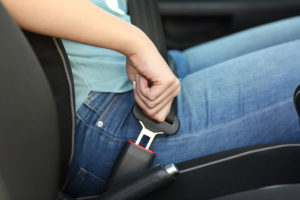How Seat Belts Keep Us Safe in an Auto Collision
October 26th, 2020 by Fix Auto USA

Wearing a seat belt can be the difference between life and death in an auto accident or collision. By wearing a seat belt when you are behind the wheel or driving with someone else, you can minimize the risk of a serious injury or fatality if an accident or collision occurs.
Seat Belt Facts
Data shows that wearing a seat belt is an effective way to limit the risk of injuries in car accidents or collisions.
According to research, wearing a seat belt properly can lower the risk of fatal injury to front-seat passengers by 45% and moderate to critical injury by 50%. Comparatively, people who do not wear a seat belt are 30 times more likely to be ejected from a vehicle during a crash, and more than 75% of people who are ejected during a fatal crash die from their injuries.
In 2019, seat belt use reached 91% in the United States; this represents an all-time high. Yet, plenty of work remains to ensure that all drivers and passengers wear a seat belt — every time, without exception.
Sharing any of the aforementioned seat belt facts with family members, friends, and others may be beneficial. In doing so, you can help these people understand the risks associated with failing to wear a seat belt. You can also use these statistics to highlight the benefits of seat belts.
Benefits of Seat Belts
There are many reasons why most car drivers and passengers wear a seat belt. These reasons include:
1. You Can Protect Yourself During an Accident or Collision
Seat belt facts and studies speak for themselves — wearing a seat belt is proven to help reduce the risk of injuries and fatalities in car accidents and collisions, regardless of whether you’re the driver or passenger.
2. Seat Belts Minimize the Risk of Severe Injuries and Costly Medical Bills
Even drivers who prioritize safety are susceptible to car accidents and collisions. In the event of one, wearing a seat belt can lower the risk of a severe injury. It can also help you avoid missing work or school to recover, as well as the expensive medical bills associated with the injuries.
3. You Can Comply with the Law
Wearing a seat belt is a privilege — not a choice. Thus, if you decide to forgo wearing a seat belt, you could receive a fine or traffic ticket. In addition, if you are not wearing a seat belt and responsible for a car accident or collision, you run the risk of losing your driver’s license, too.
4. You Can Keep Your Car Insurance Rates Low
If you receive a ticket for not wearing a seat belt, your car insurance provider will likely take notice. In this instance, you may be subject to a higher insurance premium. Or, your insurer may cancel your auto coverage.
The bottom line: the benefits of wearing a seat belt far outweigh the risks of not wearing one. Therefore, wear a seat belt any time you travel by car.
How Does a Seat Belt Keep You Safe?
When auto accidents occur, 3-point seat belts protect the driver and passengers in the following ways:
1. Occupants Won’t Fly Outside the Vehicle If Seat Belts Are Properly Worn
For a long time, people believed the myth that it was better to be thrown outside the vehicle in a serious collision. Research has since proven that being ejected results in more severe injuries and fatalities than people who remain inside.
2. Seat Belts Restrain the Hips and Shoulders
Modern seat belts are designed to restrain your body at its points of greatest strength. For adults and older children, that means the hips and shoulders. Not wearing the shoulder portion of the strap significantly reduces the safety factor of the seat belt.
3. A Seat Belt Extends the Surface Area of a Collision’s Force
To provide maximum restraint while minimizing injury, lap-and-shoulder belts spread the crash force over a wide area of the body. For drivers and front-seat passengers, shoulder straps also help keep the head and upper body from contacting the windshield, dashboard, and steering wheel, which is a leading cause of serious injuries.
4. Seat Belts Protects the Brain and Spinal Cord
Another major cause of injury in car crashes is the shift of body weight between going fast and suddenly stopping. Brain and spinal cord injuries often result from the whiplash that can occur with sudden stopping. When worn correctly, seat belts can minimize injury by reducing the speed and impact of the whiplash.
Seat Belt Laws
If you’re wondering whether it is against the law to not wear a seat belt, the answer is yes — in every state. However, there are differences in how states enforce their seat belt laws. For example, New Hampshire does not require adults to wear seat belts, but anyone under the age of 18 must buckle up. Some states don’t require backseat passengers to wear seat belts.
While not against the law, double buckling (using one seat belt to restrain two people) is highly dangerous and should not be practiced under any circumstances, especially with young children.
How To Buckle Up Correctly
People sometimes forget that seat belts have to be worn properly to provide maximum protection. The strap that goes across your lap should not be resting on the stomach. Instead, make sure it fits snugly (but not too tight) over the hips and upper thigh. The shoulder belt goes across the shoulders and upper-middle of your chest, again, snugly, but not too tight. Never secure the strap under your arms or behind your back, and don’t let it fall across your neck or face.
Seat Belt Safety for Infants and Children
The safest way for children to travel depends on their age, weight, and height. The American Academy of Pediatrics (AAP) recommends the following:
1. Rear-Facing Child Safety Seat
Children should ride in a rear-facing car safety seat as long as possible until they reach maximum weight and height restrictions stated by the manufacturer. The child should always ride in the back seat of the car.
2. Forward-Facing Child Safety Seat
Children who have outgrown rear-facing seats should use a forward-facing seat with a harness. The seat should be placed in the back seat until the child reaches the upper height or weight limit of the seat according to the child safety seat manufacturer.
3. Booster Seat
When a child exceeds the weight and height limits of a forward-facing safety seat, the child should then transition to a belt-positioning booster seat.
4. Seat Belt
When a child grows to 4 ft., 9 in. tall — usually around age 8 and 12 — he or she can begin wearing a regular seat belt. Even so, the child should remain in the rear of the car until at least age 13.
No matter what age, wearing a seat belt is serious business. Buckle up every time you get in the car. The life you save just might be your own.
This blog post was contributed by Fix Auto Pasadena, a leading industry expert and collision repair shop servicing East Los Angeles County.
Welcome to
Fix Auto USA
We are the premier independent body shop network delivering world-class customer service and high-quality collision repairs across the U.S.
Learn About Us





